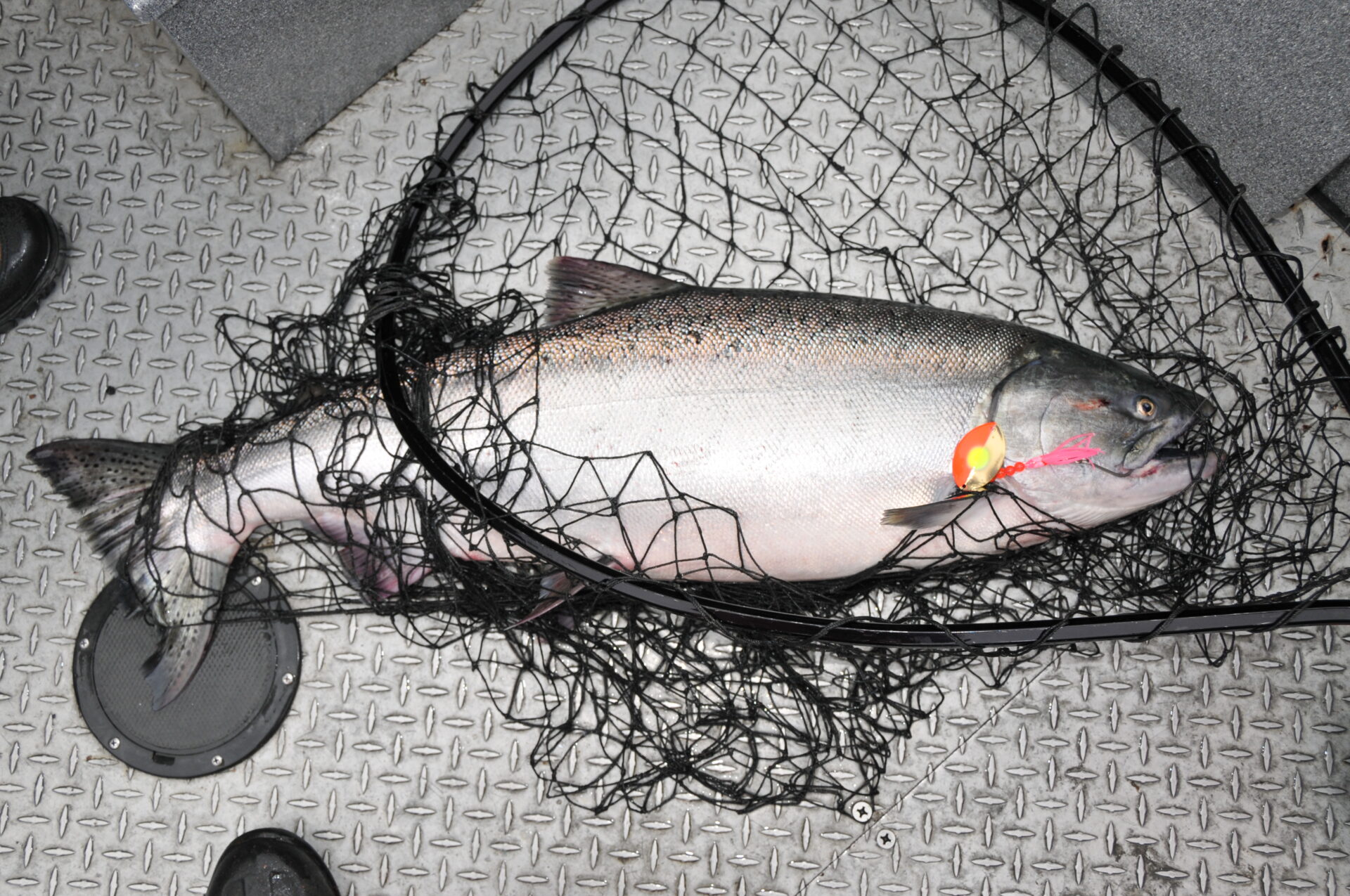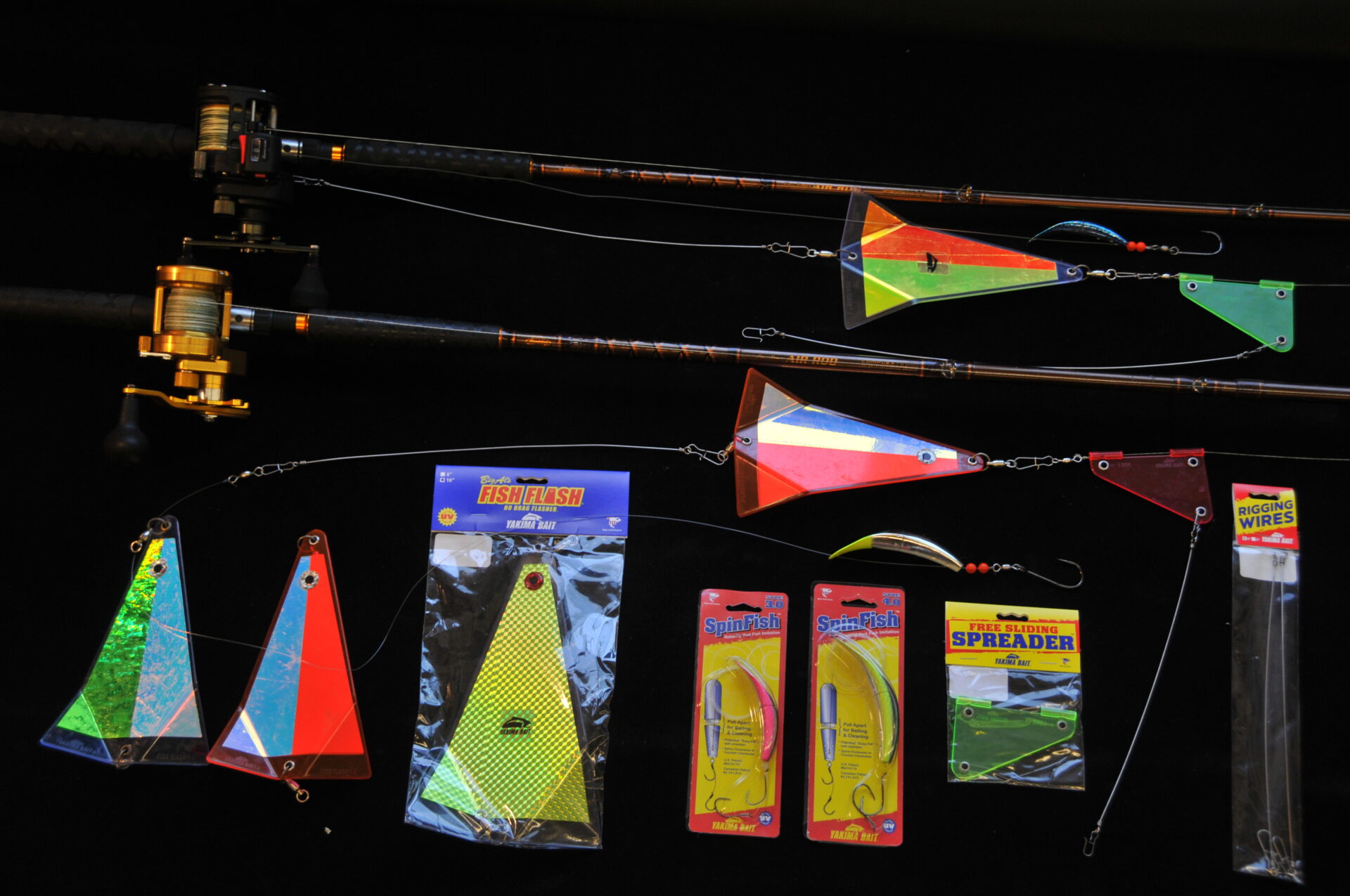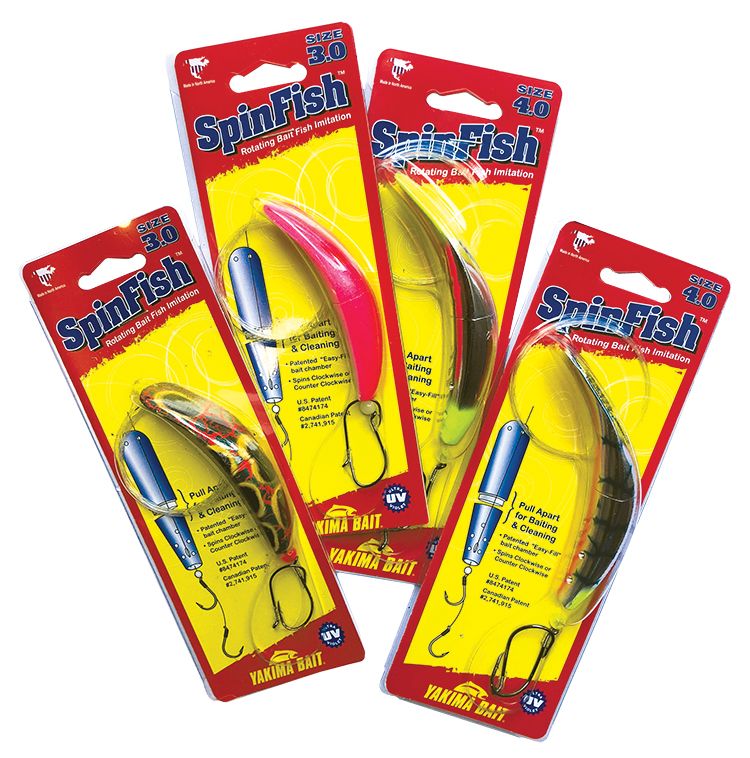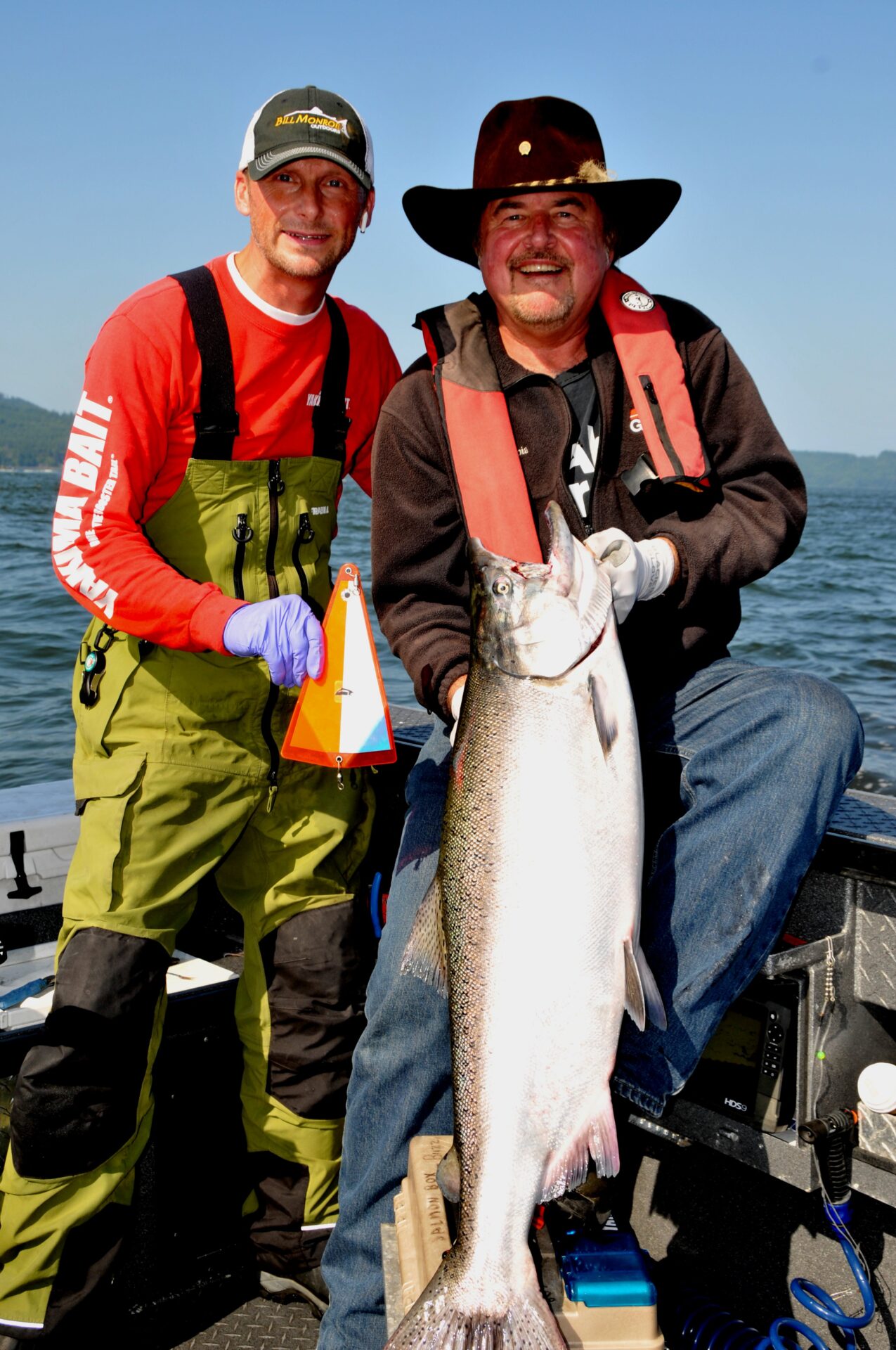Fourteen Days for Columbia Mouth Chinook
By: Buzz Ramsey

Spinners can produce salmon just as well and sometimes better than bait, especially in the eastern half of the estuary. The 5-1/2 or 6-1/2 Toman or Mulkey branded squid spinners are popularones. My go-to spinner colors include Red & White, Chartreuse/Green Dot, Pearl Red Dot,and Mexican Flag. Keep in mind you will need to set the hook when your rod first bottoms out when fishing a spinner.
This year’s chinook salmon season at the Columbia River mouth (known as the Buoy 10 fishery) is going to be a short one. The fishery is not scheduled to start until August 14 as opposed to the usual first-of-the-month start date. Since the last two weeks of August is when limits are pretty common at Buoy 10, with many of the 431,000 chinook predicted likely to return then, the delayed opener is sure to be a busy time for Astoria, Ilwaco and other nearby communities.

Rigging for Buoy 10
Use of the Free-Sliding Spreader and Rigging Wires can significantly reduces the chance of a line tangle when trolling at Buoy 10. By using a Rigging Wire as my weight dropper line and the first portion of my leader I no longer have to space my Fish Flash 20 or so inches away from my spreader. Although my total leader length (from Fish Flash to bait or spinner) is 50 or so total inches, the monofilament portion is only 36 inches long as the Rigging Wire complete with a snap and swivel makes up the first 18 inches. This short section of monofilament is much easier to untangle, should one occur, as compared to one totally made up of mono.
The one chinook or fin-clipped coho season is scheduled to last only through Thursday August 27. However, the fishery will remain open in the area extending from the Buoy 10 Channel Marker to Puget Island after the 27th but only for fin-clipped coho. As of this writing the daily limit for coho is one fish and expected to last through September 22.
While the chinook fishing should be pretty good anytime during this 14 day window ocean tides, as always, will determine the peak times to be on the water and where the salmon might be the most numerous, and biting.
For Buoy 10, the basic concept of where salmon can be found is pretty simple; fish wanting to enter the river each day collect at the mouth of the river when the tide is outgoing (ebbing) and simply allow the flooding water to carry them into the estuary. Many anglers wait for this pulse of fish near the western boundary at the beginning of the incoming tide. How far each wave of salmon will flood into the estuary just depends on how big the tide is.
A tide book or smart phone app (Ebb Tide is a reliable phone app) can provide you with the timing of the daily tide swings at various locations and tell you the amount of water being exchanged with each in-and-out tidal movement. This is important because a big tide will push more fish farther into the estuary in which case you will need to move upriver with the school, while a low exchange will cause fish to accumulate in the mid estuary, near Hammond, the west end of Desdemona Sands, or along Baker Bay, where they may linger until building tides move them eastward.

SpinFish is a new concept in combining lure and bait as the lure body can be pulled apart and filled with any bait. What we did last season at Buoy 10 was to fill the back half of the lure with chunks of anchovy and/or herring. When trolling SpinFish you will likely enjoy a better hook-to-land ratio if you let salmon pull your rod down a time or two before setting the hook. While the 3.0 and 4.0 sizes work for salmon, we had better success with the 4.0 size last season at Buoy 10.
Given reasonable water exchanges, of say seven feet or more, you will find most fish in the area extending from the west tip of Desdemona Sands eastward past the Astoria-Megler Bridge in both the north and south channel. Given these larger tides the best bite will likely occur during the last half of the flood and first half of the outgoing tide.
The Desdemona Sands Island separates the dredged, south channel from the north, false channel. Although much of the island is submerged, even at low tide, the western tip of Desdemona Sands is located two miles west of Hammond and extends eastward all the way to Rice Island. The North Channel, although ultimately a false one, maintains good depth over three miles above the Astoria-Megler Bridge and can offer success equal to the south, which is a well maintained, dredged shipping channel.
Given a decent exchange of water, your trolling strategy should be to troll upstream (the same direction as the flooding water) during the latter half of the flood and switch directions, going westward, when the tide begins to ebb. The trolling strategy here is to make mile long tacks before picking up your gear, and running back to make another pass.
What many anglers do when trolling the North Channel, is to parallel the island in 20-to-30 feet of water and make their upriver troll well past the bridge as the flood tide is nearing its peak. Once the tide changes direction and begins to ebb, they turn their boats around and troll westward.
In the south channel, since it is mostly deep water, anglers will let their lines out 20-to-30 feet on their line counter reels as many salmon will suspend at mid depth over deep water.
The daytime tides leading up to and during the August 14 opener are mild with only two feet of exchange. These soft tides will likely fill the mid estuary with salmon and given the mid-morning peak, make for pretty good fishing for those plodding this area. However, decent numbers of salmon might also be found at the top end of Blind Slough first thing in the morning as the nighttime tide is the bigger one that day and may carry salmon above the bridge where they could linger for a time.
This begins to change on August 15 as tides begin to build (5.7 feet of daytime exchange) that will likely push salmon toward the Astoria Megler Bridge resulting in some pretty good mid day catches given the 12 noon high tide. These mid day tides will continue through August 19 with each high tide occurring later in the day to the point where there will be eight feet of exchange with a 5 PM high on Saturday August 22. This will likely make for some decent afternoon catches at or above the Astoria-Megler Bridge.
One strategy that has become popular at Buoy 10 is to hold your boat into the incoming water and allow the flooding tide to push fish into your gear as you hold steady into the current – it’s back-trolling but with the bow of your boat facing westward.
Realize too that an afternoon wind coming from the west can make the water particularly rough when the tide is outgoing as compared to when it’s flooding. To avoid the big waves, try timing your afternoon trip back to Oregon when the tide is still flooding or goes slack at its peak. In addition, if you fish the evening tide east of the bridge, you may be able to escape much of the rough ride back to port (presuming you’re returning to Oregon) by launching at the East Mooring Basin or John Day boat ramp, rather than Hammond or Warrenton.

The PM high tide will flip to an AM high on August 23rd with a 5:30 high, which will mean getting on the water at the crack-of-dawn as the best AM bite will likely be during the first half of the outgo. This could result in a lot of early morning limits as the bite could begin to fade by mid morning. Keep in mind that the evening high, at 5:30 PM, is the biggest tide of the day and will likely carry a lot of salmon in with it too.
Although the AM high tides will continue until the last day of the chinook season, when we will see a 10 AM high, the amount of exchange during the morning is several feet less as compared to the evening tide. Depending on what kind of success you find during the morning high, this might be a time to catch a mid-day nap before trying your luck near or above the Astoria-Megler Bridge by trolling before and after the peak of the evening flood.
